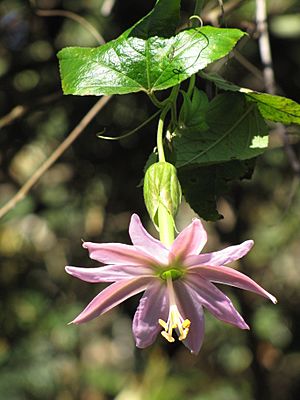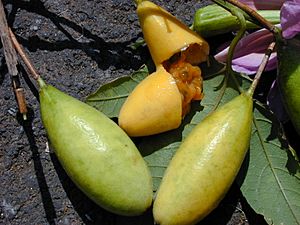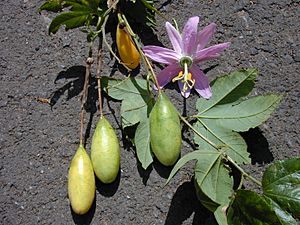Passiflora tarminiana facts for kids
Quick facts for kids Passiflora tarminiana |
|
|---|---|
 |
|
 |
|
| Scientific classification | |
| Genus: |
Passiflora
|
| Species: |
tarminiana
|
Passiflora tarminiana, also known as banana passionfruit, is a type of passionfruit plant. It gets its name because its yellow fruits look like small, straight bananas. These fruits are safe to eat.
This plant originally comes from the high mountains of tropical South America. Today, people grow it in many countries around the world. However, in places like Hawaii and New Zealand, it has become an invasive species. This means it grows too much and can harm local plants.
In New Zealand, it's called banana passionfruit. In Hawaii, it's known as banana poka. In its home countries in Latin America, it has many names like curuba, taxo, or tumbo.
Contents
What is Banana Passionfruit?
Passiflora tarminiana is a climbing vine. It has hairy stems and leaf stalks. Its leaves have three lobes, like three fingers, and are usually smooth on top but hairy underneath.
The flowers hang downwards and are usually pink. They have a special tube-like shape. The fruits are long, about 10–14 cm, and turn yellow or light orange when they are ripe. Inside, the fruit has many seeds surrounded by a tasty, orange pulp.
Where Banana Passionfruit Grows
Passiflora tarminiana is native to the high lands of tropical South America. It grows in the Andes mountains in countries like Colombia, Venezuela, Peru, and Ecuador. People have grown it there for a very long time, often at high altitudes.
Today, you can find this plant growing in many other places. It has spread naturally in countries like Australia, Guam, Hawaii, New Zealand, and Zimbabwe. It is also grown in places like California, Réunion, Mexico, and Papua New Guinea.
History and Uses of Banana Passionfruit

The banana passionfruit has been grown and eaten in the Andean valleys of South America since before the time of Christopher Columbus. People still grow it and sell its fruit in local markets today.
The fruit is edible and often eaten in South America and New Zealand. However, some people in Hawaii find the fruit not very flavorful.
Because its pink flowers are very pretty, Passiflora tarminiana is also grown as an ornamental plant in gardens. In California, it's sometimes called "softleaf passionflower."
How Banana Passionfruit Spreads
This plant can grow very quickly. Unlike many other passionfruit types, Passiflora tarminiana can pollinate itself. This means it doesn't always need another plant to make seeds.
In South America, hummingbirds and large bees help pollinate the flowers. In Hawaii, birds often visit the flowers for nectar, but they don't always help spread pollen. Bees and other insects do collect pollen there.
The seeds of the banana passionfruit are spread by animals that eat fruit. In Hawaii, feral pigs are very important for spreading the seeds. They eat the fallen fruit, and the seeds pass through their bodies unharmed. Pigs also dig up the ground, which creates good spots for the seeds to grow.
Why Banana Passionfruit is an Invasive Species
In places like Hawaii and New Zealand, Passiflora tarminiana is considered an invasive species. This means it grows very fast and can take over native forests. It can smother other plants and stop new trees from growing.
In New Zealand, it is even against the law to sell, grow, or give away these plants because of how much damage they can do. In Hawaii, banana passionfruit vines cover large areas of native forest. The seeds are spread by pigs, birds, and even people.
It is also seen as a problem plant in parts of southeastern Australia.
Sometimes, banana passionfruit is used as a base plant for grafting other types of passionfruit that are grown for food. This is especially true in cooler climates. However, if the banana passionfruit part of the plant starts to grow back from below the graft, it can become a weed. Gardeners need to watch out for this and cut back the plant if it happens.
Controlling Invasive Banana Passionfruit
Scientists and land managers are trying to control the spread of Passiflora tarminiana.
- Biological Control: In Hawaii, a fungus called Septoria passiflorae was released in 1996. This fungus can reduce the amount of banana passionfruit. It spreads with wind and rain. Two types of moths were also introduced, but they haven't been very successful.
- Physical and Chemical Control: Pulling up plants by hand or using special plant-killing chemicals (herbicides) can also help. However, these methods can be expensive and hard to use in large areas.
- New Zealand Efforts: In New Zealand, they use both physical removal and herbicides. They are also researching biological controls, but they need to be careful not to harm other important passionfruit plants.
Images for kids
See also
 In Spanish: Tumbo para niños
In Spanish: Tumbo para niños




